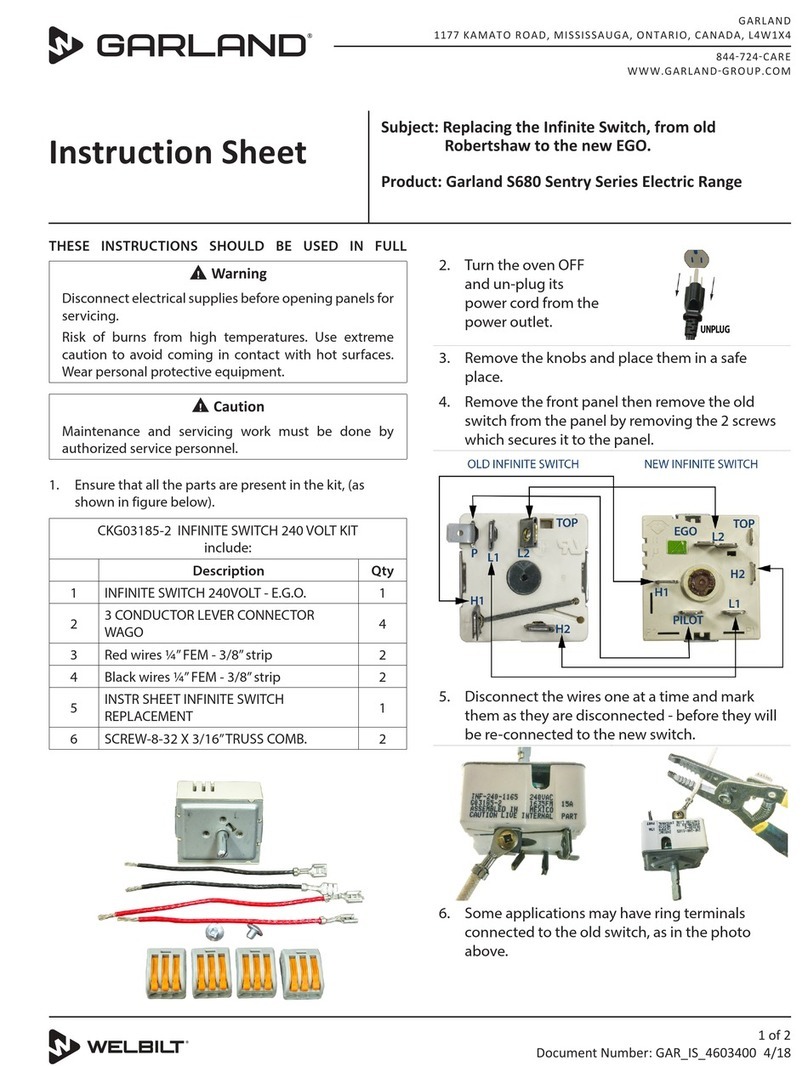
Document # G_GHD_OM_CUISINE_4605671 9/20 Page 3
TABLE OF CONTENTS
IMPORTANT INFORMATION........................2
SPECIFICATIONS ..................................4
Table A: Gas Pressures .......................................4
Table B: Model Designations .................................4
Table C: Input Rating. . . . . . . . . . . . . . . . . . . . . . . . . . . . . . . . . . . . . . . . .9
INTRODUCTION .................................10
Uncrating ..................................................10
Rating Plate ................................................10
INSTALLATION ...................................10
Clearances to Combustible Construction....................10
Installation Procedure ......................................10
Siting ......................................................11
Appliance Equipped With Casters...........................11
Appliances Equipped With Legs ............................11
Installation Instructions for Cuisine Stub Backguard.........11
Installation Instructions for Cuisine Back Risers. .............12
Installation Instructions For Cuisine Single
And Double Deck High Shelves .............................12
Installation Instructions For
Cuisine Salamander or Cheese Melter .......................13
Statutory Regulations ......................................13
Gas Supply .................................................13
Gas Supply Notes: ..........................................14
Gas Connection ............................................14
Electrical Supply (Models with Convection Oven only).......14
Assembly of Battery ........................................15
Ventilation And Air Supply..................................15
COMMISSIONING ................................16
Pressure Regulators. ........................................16
Testing and Adjustments....................................16
Pressure Settings (All Models)...............................16
Thermostat Bypass Adjustment – Oven.................17
Pilot Burner Adjustments ...................................18
General................................................18
Oven ..................................................18
Solid Hot Plate/Griddle.................................18
Front Fired Hot Top ....................................18
Broiler . . . . . . . . . . . . . . . . . . . . . . . . . . . . . . . . . . . . . . . . . . . . . . . . . 18
OPERATION .....................................18
Open Top Burners ..........................................18
Hot top and Spectro-Top Sections ..........................18
Thermostatically Controlled Griddles .......................19
Valve Controlled Griddles...................................19
Oven (Standard) ............................................19
“RC” Convection Ovens .................................... 20
Unit Broilers ................................................21
Fryers ......................................................21
MAINTENANCE AND CLEANING...................21
Seasoning..................................................21
Griddle Seasoning .....................................21
Seasoning Cast Iron Top Grates.........................21
Cleaning ...................................................21
General Cleaning ......................................21
Stainless Steel Exterior and Standard Oven
Interior Finishes........................................22
Oven Interior (Optional Porcelain Enamel Finish)........22
Griddle Cleaning.......................................23
Open Top Burners .....................................23
Cast Iron Top Grates....................................23
Cast Iron Hot tops and Spectro-Heat Tops ..............23
Broiler Cleaning ........................................... 24
C36-NRR/C36-NRC Models .............................24
C36-ABR/C36-ABC Models .............................24
C36-ARR/C36-ARC Models .............................24
Adjustments .............................................. 24
Oven Orice ...........................................24
Pilot Adjustments......................................24
Automatic Pilot Valve ..................................25
Burner Gas/Air Adjustments............................25
CONVECTION OVEN PRODUCT APPLICATION . . . . . . 25
PROBLEM/SOLUTIONS CONVECTION OVEN........26
SERVICING ......................................27
Thermostat Calibration .................................... 27
Cleaning/Servicing Burners ................................ 27
Open-Type Burners ....................................27
Front Fired Solid Top Burners...........................27
Solid Hot Plate/Griddle Burners ........................27
Standard Oven Burners ................................28
RC Oven Burners.......................................28
Broiler . . . . . . . . . . . . . . . . . . . . . . . . . . . . . . . . . . . . . . . . . . . . . . . . . 28
Pilot Burner Cleaning ...................................... 28
Oven Top/Hot Top/Griddle/Broiler/Front Fired Top......28
Oven ..................................................28
REPLACEMENT OF PARTS.........................29
Gas Valves................................................. 29
Oven Thermostat.......................................... 29
Power Switch.............................................. 30
Door Switch ............................................... 30
Oven Pilot................................................. 30
Convection Ovens - Spark Module ......................... 30
Convection Oven Motor ................................... 30
TROUBLESHOOTING GUIDE ......................31




























